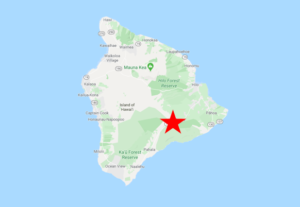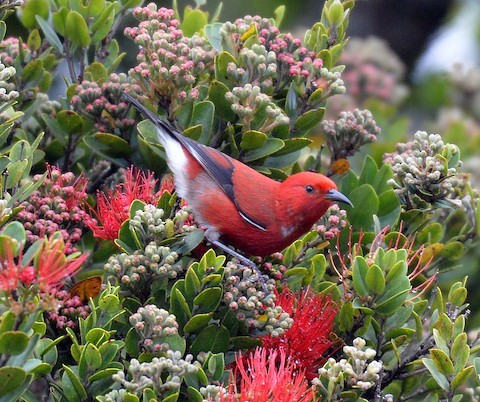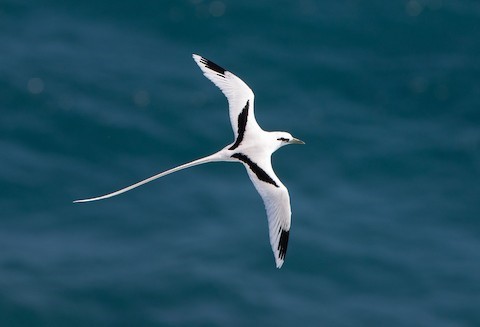Hawaii Volcanoes National Park, Big Island, Hawaii

Hawaii Volcanoes National Park has a well-deserved reputation for scenic grandeur, fascinating geological formations, and the thrills of persistent volcanic activity. This awe-inspiring landscape is home to three Big Island endemics—Hawaiian Hawk, Hawaii Elepaio, and Oma’o—and several multi-island endemics: Hawaiian Goose, “Hawaiian Noddy”, Apapane, I’iwi, Common Amakihi. Other notable avian highlights include locally numerous Kalij Pheasant and Yellow-billed Tropicbird nesting in the active part of the volcano.
Orientation
Directions
The main visitor facilities and headquarters area of Hawaii Volcanoes National Park are in the southeastern portion of the Big Island, about 45 minutes’ drive (30 miles) southwest of Hilo and two hours (100 miles) southeast of Kailua-Kona.
From Hilo International Airport. Turn left (south) onto Kanoelehua Avenue (which is also Route 11 and drive 27.7 miles to reach the Crater Rim Drive turnoff to Kilauea Visitor Center.
From Kona International Airport. There are two nearly equidistant routes to Kilauea Visitor Center. The simplest is via the South Point area. Take Route 19 south (its number soon changes from 19 to 11 and it becomes the Mamalahoa Highway) and remain on it for 102 miles as it wraps around the southern reaches of the island, then heads northeast through the park.
Alternatively, to take the northern route via Hilo: from Kona airport, take Route 19 south for 1.2 miles, turn east on Kaiminani Drive, and go 3.6 miles to the T-junction with the Mamalahoa Highway (also part of the Hawaii Belt Road and Route 190).
Turn north on the Belt Road, go 19.4 miles to lower end of Daniel K. Inouye Highway, turn right and take this road for 9.6 miles to its junction with Saddle Road. Turn south onto Saddle Road and go 40 miles to the University of Hawaii – Hilo Campus, then turn right and an immediate left Puainako Street for another two miles to Route 11. Turn right onto Route 11 and drive 25.8 miles to reach the turnoff to Kilauea Visitor Center.
Birdfinding
Hawaii Volcanoes National Park is large and offers many areas to explore, too many to fit into a single visit. Most visitors will presumably want to see the volcanic and scenic highlights of Kilauea Crater, Crater Rim Drive, and Chain of Craters Road. The standard park visitor’s agenda should provide opportunities to see most of the birds the park is known for, including Hawaiian Goose, Kalij Pheasant, Yellow-billed Tropicbird, Hawaii Elepaio, Oma’o, Apapane, and Common Amakihi. A visitor who hopes to find I’iwi and some of the rarer species is probably best advised to focus on the Mauna Loa Strip Road.
Kilauea Crater Rim. The core developed area of the park is centered on Kilauea Crater, which is encircled by Crater Rim Drive—although volcanic activity has caused a long-term partial closure, limiting traffic to the northern and eastern portions of the crater rim. Part of the area is heavily forested and part of it is a volcanic moonscape.

Apapane is abundant in forests around the Kilauea Crater Rim. © Dan Murphy

Several of the trails that weave through the forests and volcanic formations can be productive for Kalij Pheasant, Hawaiian Hawk, Hawaii Elepaio, Oma’o, Japanese Bush-Warbler, Warbling White-eye, Apapane, and Common Amakihi. The Kilauea Iki Trail (across from the ever-popular Thurston Lava Tube Trail) is often the most productive for birds.
Along the northwestern portion of Crater Rim Drive, open grassy areas around the Jaggar Museum and Kilauea Overlook often have park-tame Hawaiian Goose can often be seen along the roadside. The crater itself has nesting Yellow-billed Tropicbirds, which somehow survive on its walls amid the continuously venting volcanic fumes.

Volcano Golf Course. Across the Mamalahoa Highway from the Visitor Center area is the Keauhou Ranch subdivision of the town of Volcano, home to the Volcano Golf Course. The golf course is known for Hawaiian Goose. To reach the golf course, take Pi’i Mauna Drive north from the highway. After a thin strip of woods and houses, Pi’i Mauna enters the golf course and the geese can often be seen immediately. The golf course is also a consistent spot for Kalij Pheasant and Pacific Golden-Plover.
Mauna Loa Strip Road. The most reliable area in the park to find I’iwi, with an extremely slim chance at three super-rare honeycreepers—Akiapola’au, Hawaii Creeper, and Hawaii Akepa—is along Mauna Loa Strip Road. Other species often found along the road include: Erckel’s Francolin, Kalij Pheasant, Hawaiian Hawk, Hawaii Elepaio, Oma’o, Japanese Bush-Warbler, Warbling White-eye, Red-billed Leiothrix, Chinese Hwamei, and abundant Apapane and Common Amakihi.

Male Kalij Pheasant at Volcano House, Hawaii Volcanoes National Park. © Tresa Moulton
The road begins from a junction on the main road (Route 11), just west of the park entrance, and climbs for 11.2 miles northwest toward the summit of Mauna Loa, ending at an elevation of 6,662’. The entire road is paved, but most of it is narrow, effectively one-lane, and requires attentive, patient driving.
About a mile and a half from the highway, the first forested area along the road is Kipuka Puaulu, also known as “Bird Park” although it is not usually the best area for birds. There is a small parking area and a loop trail through impressive old growth forest. All of the species listed above, except the rarer honeycreepers, are likely to be present, but most are difficult to see because of poor visibility along the trail.
About a mile past Kipuka Puaulu, the next forested area is Kipuka Ki. Find a safe place to pull off, then walk along the road. This is usually more productive than walking the “Bird Park” trail—all the same species, but with much better visibility.

The fabulous I’iwi is no longer seen regularly around Kilauea Crater, but can still be found along the Mauna Loa Strip Road. © Sharif Uddin
Beyond Kipuka Ki, the road passes through a mix of forest, meadow, and open woodland. At around the mid-point (5.5 miles from the highway) the road crosses a powerline cut, which is a good opportunity to park and walk.
The upper half of the road winds through fairly extensive kipukas and the probability of finding I’iwi generally increases along with the elevation. The species has become uncommon, so it is easy to miss. A recommended approach is to find a patch ohia trees in full bloom and wait for the I’iwi to show up.
The odds of finding Akiapola’au, Hawaii Creeper, or Hawaii Akepa are extremely low overall, but the uppermost kipuka, which sits between 5,600’ and 6,600’ elevation, would seem to have inherent potential, as each of these species have substantial populations in publicly inaccessible forests at the same elevation approximately three miles northeast.
Starting at the end of the road, the trail up Mauna Loa is a formidable undertaking. The first short segment passes through the last of the kipuka, then the trail goes through alpine meadows and soon transitions to lavafields. Erckel’s Francolin is especially frequent in this area.
Chain of Craters Road. The road south and east from Volcano formerly connected to Route 130 and Hilo, but an eruption in 1989 buried a large section under lava, so it is now a one-way route to the park’s eastern coastline, ending in the vicinity of the Holei Sea Arch.

“Hawaiian Noddy” along Chain of Craters Road. © Dean LaTray
For its last mile and a half, the road hugs the coastline and passes beside sea cliffs formed from ancient lava flows collapsing into the pounding sea. The cliffs support a significant breeding population of “Hawaiian Noddy”. The noddies nest year-round in loose colonies, and can be seen at a few points along the road. They are reliably present and observable at the Holei Sea Arch overlook and at a pullout 0.3 miles to the west.
This coastline is not especially productive for seabird diversity. Despite consistent attention from observers, only the noddy is seen often. Other seabirds seen occasionally include Yellow-billed Tropicbird, Wedge-tailed Shearwater, and Great Frigatebird. Hawaiian Goose and Pacific Golden-Plover are often present along the road.
Hilina Pali Road. The Hilina Pali Road branches west from Chain of Craters Road at the 2.2-mile point. It formerly traversed over twelve miles to reach the Hilina Pali Overlook, but it now ends after 5.5 miles at the Kulanaokuaiki Campground just past the meadows and woodlands of Kipuka Nene. Beyond that point, the formerly drivable road continues as a hiking trail to the overlook.
The kipuka traditionally supports a small breeding population of its eponymous Hawaiian Geese. This area has a history of Red-billed Francolin sightings from the 1970s into the 1990s, with few into the early 2000s, but it seems likely that this small, isolated population has vanished.
Services
Accommodations
Within the park, the venerable Volcano House (1-844-569-8849) hotel offers lodgings on the rim of Kilauea Crater. The original structure built in 1877 now houses an art gallery, the Volcano Art Center. The current hotel dates back 1941.
Just outside the park, in the core of the village of Volcano, Kilauea Lodge (1-808-967-7366) is a popular alternative.
A two-mile drive from the crater, in the Keauhou Ranch subdivision of Volcano, tucked away in the woods, is Kilauea House, 1-808-209-8230.
A 30-mile drive west of the park toward South Point, the nearest beachside hotel is Sea Mountain, 1-808-928-6200.
Food
Dining options within the park are limited—the Volcano House restaurant has a view of the fuming sulfurous vents of Halemaumau. Breakfast and dinner are generally more pleasant than lunch because the midday hours bring so many tourists up from the coastal resorts that it is often overrun.
In Volcano, Kilauea Lodge operates a popular restaurant, and there are a few small restaurants and cafes. The nearest supermarket is a 20-mile drive toward Hilo in Kea’au.
Notes
Hazards & Hassles
Proximity to an active volcano carries obvious risks, but also some more subtle risks. In the latter category is the potential for sulfurous fumes to form an acidic layer and degrade optics—so be sure to wipe your lenses clean regularly during times when they might be exposed to fumes (even diffuse fumes).
Links

